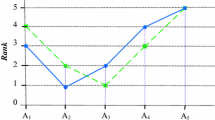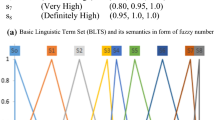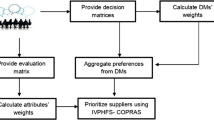Abstract
This paper studies a linear programming (LP) and a multiple attribute decision-making (MADM) model with hesitant fuzzy numbers (HFNs) for solving group decision-making problems under uncertainty. We introduce a new type of HFN whose flexibility allows for its direct application to standard LP and MADM methods while facing credibility considerations or strategic reports from the experts evaluating the alternatives. These problems are initially formulated as models with uncertain, crisp data. Decision makers and experts are then invited to evaluate the data and propose HFNs representing its credibility. As a result, the crisp LP and MADM techniques are transformed into hesitant fuzzy LP (HFLP) and MADM (HF-MADM) models. The popular simplex method and the steps defining the corresponding MADM model, namely, the Technique for Order of Preference by Similarity to Ideal Solution (TOPSIS), are extended to implement the new HFNs. The strategic environment introduced allows for the definition of selection strategies and equilibria determined by the credibility profiles of experts providing evaluations. Develo** a probabilistic framework applicable to these models would require defining convolution functions that become increasingly complex as further experts are added to the analysis. We present several numerical comparisons between the proposed hesitant fuzzy simplex and MADM results and those derived from the initial crisp models. The strategic importance of data credibility as a fundamental determinant of the optimality of results obtained will also be highlighted.




Similar content being viewed by others
Data availability
Enquiries about data availability should be directed to the authors.
References
Ambrin R, Ibrar M, De La Sen M, Rabbi I, Khan A (2021) Extended TOPSIS method for supplier selection under picture hesitant fuzzy environment using linguistic variables. J Math 2021:1–28
Amin F, Fahmi A, Abdullah S (2019) Dealer using a new trapezoidal cubic hesitant fuzzy TOPSIS method and application to group decision-making program. Soft Comput 23:5353–5366
Atanassov KT (1983) Intuitionistic fuzzy sets. In: Sgurev V (ed) VII ITKR’S session sofia jone. Sofia, London
Bazaraa MS, Jarvis JJ, Sherali HD (2010) Linear programming and network flows. Wiley, Hoboken
Bellman RE, Zadeh LA (1970) Decision-making in a fuzzy environment. Manag Sci 17(4):141–164
Bharati SK (2018) Solving optimization problems under hesitant fuzzy environment. Life Cycle Reliab Saf Eng 7:127–136
Chang CT (2007) Binary behaviour of fuzzy programming with linear membership. IEEE Trans Fuzzy Syst 15(4):710–717
Chen N, Xu Z, **a M (2013) Interval valued hesitant preference relations and their applications to group decision making. Knowl Based Syst 37:528–540
Deli I (2020) A TOPSIS method by using generalized trapezoidal hesitant fuzzy numbers and application to a robot selection problem. J Intell Fuzzy Syst 38(1):779–793
Deli I (2021) Bonferroni mean operators of generalized trapezoidal hesitant fuzzy numbers and their application to decision-making problems. Soft Comput 25(6):4925–4949
Deli I, Karaaslan F (2021) Generalized trapezoidal hesitant fuzzy numbers and their applications to multi criteria decision-making problems. Soft Comput 25(2):1017–1032
Denoeux T (2014) Dempster-shafer theory, application to clustering, RSKT, October, 5, 2014, Shanghai, China
Di Caprio D, Santos-Arteaga FJ (2011) Strategic diffusion of information and preference manipulation. Int J Strat Decis Sci 2(2):1–19
Dong Y, Zha Q, Zhang H, Herrera F (2020) Consensus reaching and strategic manipulation in group decision making with trust relationships. IEEE Trans Syst Man Cybern Syst 51(10):6304–6318
Dutta B, Dao SD, Martínez L, Goh M (2021) An evolutionary strategic weight manipulation approach for multi-attribute decision making: TOPSIS method. Int J Approx Reason 129:64–83
Elouataoui W, Alaoui IE, Gahi Y (2022) Data quality in the era of big data: a global review. In: Baddi Y, Gahi Y, Maleh Y, Alazab M, Tawalbeh L (eds) Big data intelligence for smart applications. Studies in computational intelligence, vol 994. Springer, Cham. https://doi.org/10.1007/978-3-030-87954-9_1
Fahmi A, Abdullah S, Amin F (2021) Aggregation operators on cubic linguistic hesitant fuzzy numbers and their application in group decision-making. Granular Comput 6:303–320
Garg H, Keikha A, Nehi HM (2020) Multiple-attribute decision making problems using TOPSIS and Choquet integral with hesitant fuzzy number information. Math Problems Eng 12:1
Garmendia L, Campo GD, Recasens J (2017) Partial orderings for hesitant fuzzy sets. Int J Approx Reason 84:159–167
Grabisch M, Marichal JL, Mesiar R, Pap E (2009) Aggregation functions. University Press, Cambridge
Hu J, **ao K, Chen X, Liu Y (2015) Interval type-2 hesitant fuzzy set and its application in molti-criteria decision making. Comput Ind Eng 2015:1
Imran M, Ahmad A (2021) Enhancing data quality to mine credible patterns. J Inf Sci. https://doi.org/10.1177/01655515211013693
Karaaslan F, Al-Husseinawi AH (2022) Hesitant T-spherical Dombi fuzzy aggregation operators and their applications in multiple criteria group decision-making. Complex Inell Syst 2022:3279–3297
Kaya SK, Erginel N (2020) Futuristic airport: a sustainable airport design by integrating hesitant fuzzy SWARA and hesitant fuzzy sustainable quality function deployment. J Clean Prod 275:123880
Keikha A (2021a) Introducing a new type of HFSs and their application in solving MADM. J Intell Fuzzy Syst 2021:1–12
Keikha A (2021b) Archimedean t-norm and t-conorm-based aggregation operators of HFNs with the approach of improving education. Int J Fuzzy Syst. https://doi.org/10.1007/s40815-021-01137-3
Klir GJ (2006) Uncertainty and information: foundations of generalized information theory. Wiley, Hoboken
Lalotra S, Singh S (2020) Knowledge measure of hesitant fuzzy set and its application in multi attribute decision making. Comput Appl Math 2020:39–86
Liao H, Xu Z (2013) A VIKOR-based method for hesitant fuzzy multi criteria decision making. Fuzzy Optim Decis Mak 12:373–392
Liao HC, Xu Z (2014) Subtraction and division operations over hesitant fuzzy sets. J Intell Fuzzy Syst 27(1):65–72
Liao H, Xu Z (2017) Hesitant fuzzy decision making methodologies and applications. Springer, Singapore
Liao H, Xu Z, **a M (2014a) Multiplicative consistency of hesitant fuzzy preference relation and its application in group decision making. Int J Inf Technol Decis Mak 13(1):47–76
Liao H, Xu Z, Zang X (2014b) Distance and similarity measures for hesitant fuzzy linguistic term sets and their application in multi criteria decision making. Inf Sci 271:125–142
Liao H, Wu X, Keikha A, Hafezalkotob A (2018) Power average-based score function and extension rule of hesitant fuzzy set and the hesitant power average operators. J Intell Fuzzy Syst 35(3):3873–3882
Liu X, Ju Y, Yang S (2016) Some generalized interval valued hesitant uncertain linguistic aggregation operators and their applications to multiple attribute group decision making. Soft Comput 20:495–510
Liu F, Fan C, **e W (2018) Type-2 hesitant fuzzy sets. Fuzzy Inf Eng 10(2):249–259
Liu P, Saha A, Datta D, Kar S (2020) Multi attribute decision making using hesitant fuzzy Dombi–Archimedean weighted aggregation operators. Int J Comput Intell Syst 2020:386–411
Liu Y, Li Y, Zhang Z, Xu Y, Dong Y (2022) Classification-based strategic weight manipulation in multiple attribute decision making. Expert Syst Appl 197:116781
Mahmood T, Ahsen M, Ali Z (2021a) Multi-attribute group decision-making based on Bonferroni mean operators for picture hesitant fuzzy numbers. Soft Comput 25:13315–13351
Mahmood TA, Ali TW, Chinram ZR (2021b) Power aggregation operators and similarity measures based on improved intuitionistic hesitant fuzzy sets and their applications to multiple attribute decision making. Comput Model Eng Sci 2021:1
Maleki HR, Tata M, Mashinchi M (2000) Linear programming with fuzzy variables. Fuzzy Sets Syst 109:21–33
Marlow T, Miller S, Roberts JT (2021) Bots and online climate discourses: Twitter discourse on President Trump’s announcement of US withdrawal from the Paris Agreement. Clim Policy 21(6):765–777
Meng F, Wang C, Chen X (2016) Linguistic interval hesitant fuzzy sets and their application in decision making. Cogn Comput 8:52–68
Pollack HN (2003) Uncertain science … uncertain world. Cambridge University Press, Cambridge
Qi X, Liang C, Zhang J (2016) Multiple attribute group decision making based on generalized power aggregation operators under interval-valued dual hesitant fuzzy linguistic environment. Int J Mach Learn Cybern 7:1147–1193
Ranjbar M, Effati S (2020) Symmetric and right-hand-side hesitant fuzzy linear programming. J IEEE Trans Fuzzy Syst 28(2):215–227
Ranjbar M, Miri SM, Effati S (2020) Hesitant fuzzy numbers with (alpha, k)-cuts in compact intervals and applications. Expert Syst Appl 2020:151
Ranjbar M, Effati S, Miri S (2022a) Fully hesitant fuzzy linear programming with hesitant fuzzy numbers. Eng Appl Artif Intell 2022:15047
Ranjbar M, Miri SM, Effati S (2022b) Arithmetic operations and ranking of hesitant fuzzy numbers by extension principle. Iran J Fuzzy Syst 19(1):97–114
Rouhbakhsh FF, Ranjbar MM, Effati S, Hassanpour H (2020) Multi objective programming problem in the hesitant fuzzy environment. Appl Intell 2020:1
Saghi S, Nazemi A, Effati S, Ranjbar M (2023) Simplex algorithm for hesitant fuzzy linear programming problem with hesitant cost coefficient. Iran J Fuzzy Syst 20(1):137–152
Santos Arteaga FJ, Di Caprio D, Tavana M, Cerdá Tena E (2023) A credibility and strategic behavior approach in hesitant multiple criteria decision-making with application to sustainable transportation. IEEE Trans Fuzzy Syst 31(2):460–474
Sarkar A, Biswas A (2019) Multi-criteria decision-making using Archimedean aggregation operators in Pythagorean hesitant fuzzy environment. Int J Intell Syst 34(7):1361–1386
Schmid-Petri H, Bürger M (2022) The effect of misinformation and inoculation: Replication of an experiment on the effect of false experts in the context of climate change communication. Public Underst Sci 31(2):152–167
Smithson M (1989) Ignorance and uncertainty: emerging paradigms. Springer, New York
Sun QP, Oyuang JW (2015) Hesitant fuzzy multi attribute decision daking based on TOPSIS with entropy-weighted method. Manag Sci Eng 9(3):1–6
Tong X, Yu L (2016) MADM based on distance and correlation coefficient measures with decision maker preferences under a hesitant fuzzy environment. Soft Comput 20:4449–4461
Torra V (2010) Hesitant fuzzy sets. Int J Intell Syst 25:529–539
Torra V, Narukawa Y (2009) On hesitant fuzzy sets and decision. In: The 18th IEEE international conference on fuzzy systems. Jeju Island, Korea
Touqeer M, Umer R, Ahmadian A, Salahshour S, Salimi M (2022) Signed distance-based closeness coefficients approach for solving inverse non-linear programming models for multiple criteria group decision-making using interval type-2 pythagorean fuzzy numbers. Granular Comput 7(4):881–901
Tzeng GH, Huang JJ (2011) Multiple attribute decision making methods and application. CRC, London
Wang X, Triantaphyllou E (2008) Ranking irregularities when evaluating alternatives by using some electre methods. Omega Int J Manag Sci 36:45–63
Wei G, Zhao X, Lin R, Wang H (2014) Approaches to hesitant fuzzy multiple attribute decision making with incomplete weight information. J Intell Fuzzy Syst 26:259–266
Wei G, Alsaadi FE, Hayat T, Alsaedi A (2016) Hesitant fuzzy linguistic arithmetic aggregation operators in multiple attribute decision making. Iran J Fuzzy Syst 13(4):1–16
Winston WL (2004) Operations research: applications and algorithms. Duxbury Press, London
**a M, Xu Z (2011) Hesitant fuzzy information aggregation in decision making. Int J Approx Reason 52(3):395–407
Xu Z, **a M (2011a) Distance and similarity measures for hesitant fuzzy sets. Inf Sci 181:2128–2138
Xu Z, **a M (2011b) On distance and correlation measures of hesitant fuzzy information. Int J Intell Syst 26:410–425
Yager R (1988) On ordered weighted averaging aggregation operators in multi-criteria decision making. IEEE Trans Syst Man Cybern 18:183–190
Yager R (2001) The power average operator. IEEE Trans Syst Man Cybernet Part A Syst Hum 31(6):1
Yahya M, Abdullah SS, Chinram R, Al-Otaibi Y (2021) Frank aggregation operators and their application to probabilistic hesitant fuzzy multiple attribute decision making. Int J Fuzzy Syst 2021:1945–2215
Ye M, ** J, Feng Y (2020) Negations and aggregation operators based on a new hesitant fuzzy partial ordering. Iran J Fuzzy Syst 17(1):1–12
Zadeh LA (1965) Fuzzy sets. Inf Control 8:338–353
Zadeh LA (1975) The concept of a linguistic variable and its application to approximate reasoning-1. Inf Sci 8:199–249
Zhang Z (2016) Several new hesitant fuzzy aggregation operators and their application to multi-criteria decision making. Proc Natl Acad Sci India Sect A Phys Sci 2016:377–393
Zhang F, Chen SJL, Huang W (2016a) New distance measures on hesitant fuzzy sets based on the cardinality theory and their application in pattern recognition. Soft Comput Methodol Appl 2016:1
Zhang X, Xu Z, **ng X (2016b) Hesitant fuzzy programming technique for multidimensional analysis of hesitant fuzzy preferences. OR Spect Quant Approaches Manag Springer Gesellschaft Oper Res 38(3):789–817
Zhong Y, Cao L, Zhang H, Qin Y, Huang M, Luo X (2022) Hesitant fuzzy power Maclaurin symmetric mean operators in the framework of Dempster–Shafer theory for multiple criteria decision making. J Ambient Intell Humaniz Comput 2022:1–21
Acknowledgements
Dr. Francisco J. Santos-Arteaga is grateful for the support received from the María Zambrano contract from the Universidad Complutense de Madrid financed by the Ministerio de Universidades with funding from the European Union Next Generation program.
Funding
The authors have not disclosed any funding.
Author information
Authors and Affiliations
Corresponding author
Ethics declarations
Conflict of interest
The authors have not disclosed any conflict of interest.
Additional information
Publisher's Note
Springer Nature remains neutral with regard to jurisdictional claims in published maps and institutional affiliations.
Rights and permissions
Springer Nature or its licensor (e.g. a society or other partner) holds exclusive rights to this article under a publishing agreement with the author(s) or other rightsholder(s); author self-archiving of the accepted manuscript version of this article is solely governed by the terms of such publishing agreement and applicable law.
About this article
Cite this article
Tavana, M., Keikha, A. & Santos-Arteaga, F.J. A hesitant fuzzy group decision-making framework with data credibility and strategic evaluations. Soft Comput (2023). https://doi.org/10.1007/s00500-023-09497-8
Accepted:
Published:
DOI: https://doi.org/10.1007/s00500-023-09497-8




